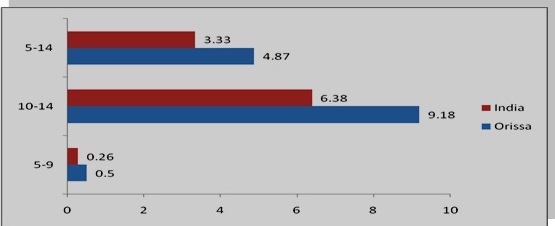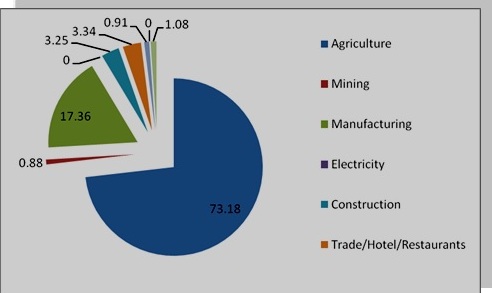Child Labour in Odisha
The State of Orissa : At a glance
On the eastern coast of India, Orissa lies between 170. 15’ and 220.45’ in the North latitude and between 810.45’ and 870.50’ East Longitude. The state is bounded by Jharkhand on the north, West Bengal on the north-east, Chhatisgarh on the west, Andhra Pradesh on the south and the Bay of Bengal on the East. The state lies in a sub-tropical geo-climatic zone and is broadly divided into four distinct natural physiographic regions viz. 1) northern plateau and upland region, 2) central table land, 3) eastern ghat region and 4) coastal belt. Administratively, Orissa has three revenue divisions, 30 districts, 58 sub-divisions, 171 tehsils and 314 community development blocks, 138 towns, 6235 Gram Panchayats and 51,349 villages.
Orissa , with 36.71 million people (2001 census ), accounts for 3.57% of the population of the country and hence the state is 8th largest and 11th most populous state in the country. Nearly 85% of its population live in the rural areas and depend mostly on agriculture for their livelihood.
Sex Ratio
The sex ratio in the state i.e. number of females per 1000 males marginally increased from 971 in 1991 to 972 in 2001 as compared to all India average which increased from 927 to 933 during the corresponding period. On the literary front the achievement has been impressive as the literacy rate increased from 49.1% in 1991 to 63.6% in 2001 as against an increase from 52.1% to 65.4% at the national level during the same period. The male and female literacy rates which were 63.1% and 34.7% in 1991 have increased to 76.1% and 51.0% respectively in 2001.
Workforce
The Census in India divides all workers into main and marginal. The main workers have to work at least six months in the reference year to earn the status and marginal workers work less than six months. Census of 2001 enumerated 14.3 million workers in the population of 36.7 million in Orissa. Of the workers, 9.6 million were main workers and 4.7 million marginal.
Child Labour Scenario in Odisha
- The number of working children identified through the survey conducted by the State Labour Department in pursuance of the directions of the Supreme Court in CWA 465 MC Mehta vrs State of Tamilnadu on 10.12.96 – 2,15,222;
- Findings of the Department of School and Mass Education through the survey conducted by Sarva Shikshya Abhiyan in 2007-08 indicate the number of out of school children at 2.70 lakh;
- Findings of the NSSO Survey (55th & 61st round):
- 55th round – 2.4 lakh;
- 61st round – 1.87 lakh.
On the basis of the empirical studies/surveys working children in different districts are concentrated in certain occupations/processes which are injurious to human life and limb and detrimental to growth and development of children. These are:- Agriculture, Beedi rolling, labeling and packaging, Collection and processing of minor forest produce, Forest timber operations, Hotels/motels/road side dhabas, Domestic help, Collection and assembly of charcoal and coal, Cattle and goat rearing, Operations in motor garages, Operations in brick kilns, Operations in stone quarries, Stone crushing, Fire works, Weaving and dying, Rag picking, Wood processing, Clay image making, Transport operations, Loading and unloading in mining areas, Building and construction operations, Biscuit and Bread making, Selling of country liquor, Cotton ginning, Cycle/automobiles repairs and Shops & commercial establishment.
- Of the total child population in the age group of 5-14 of 86.34 lakh, 3.78 lakh (4.4%) were engaged in various economically gainful activities and 94.4 per cent of them were engaged in rural areas
- 1.10 lakh (29.1%) children were categorised as main workers while 2.68 lakh (70.9%) were marginal workers
Work Participation Rate of Child Labour by Age in India and Orissa

Sectoral Distribution
- A substantial proportion of the child labour in the state is engaged in agriculture and allied activities in India. This sector alone account for over two thirds of the child employment
- Manufacturing sector account for more than 15 percent of child employment followed by Trade, hotels and restaurant

( Source : Manual prepared by V.V.G.N.L.I, Noida)